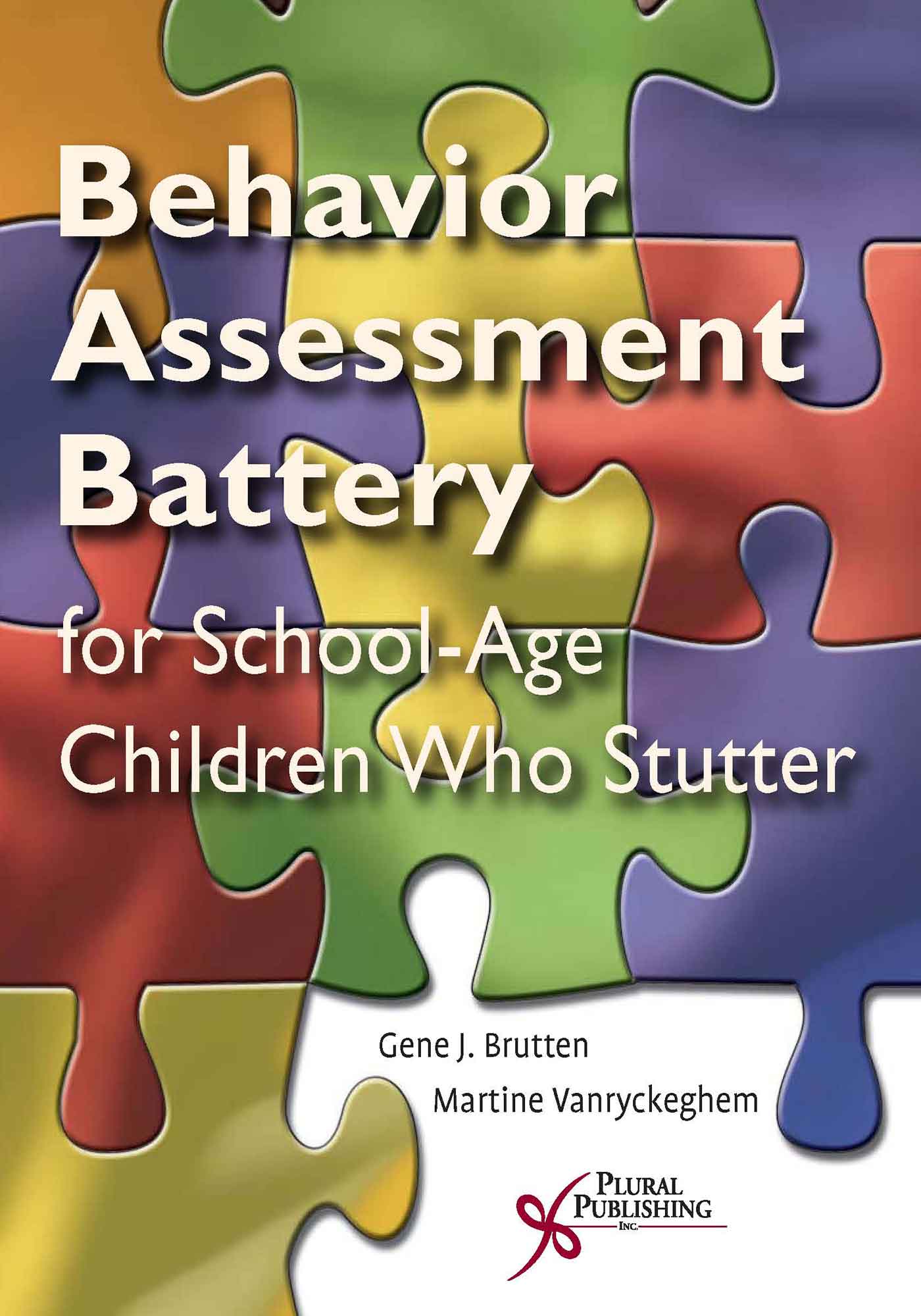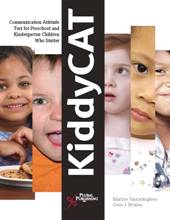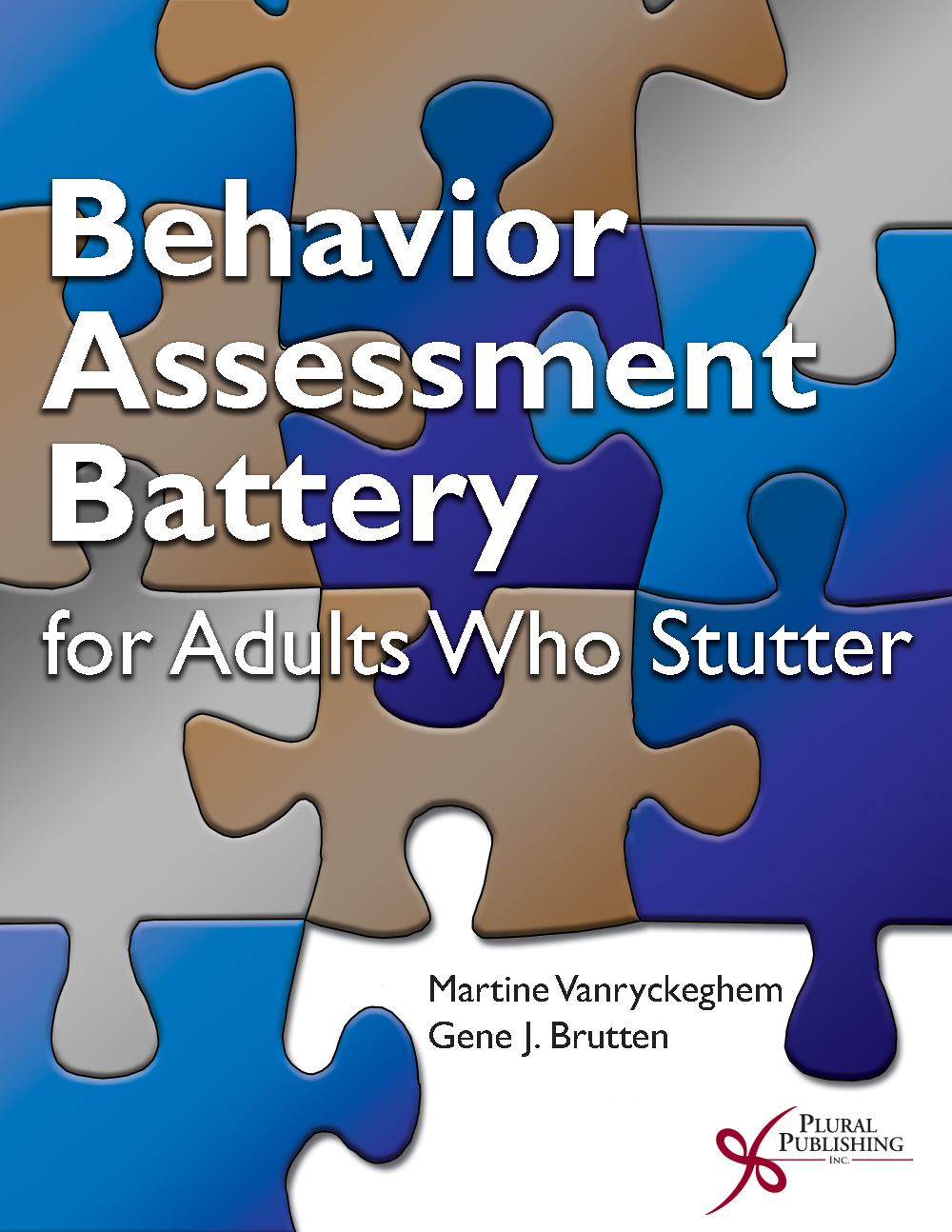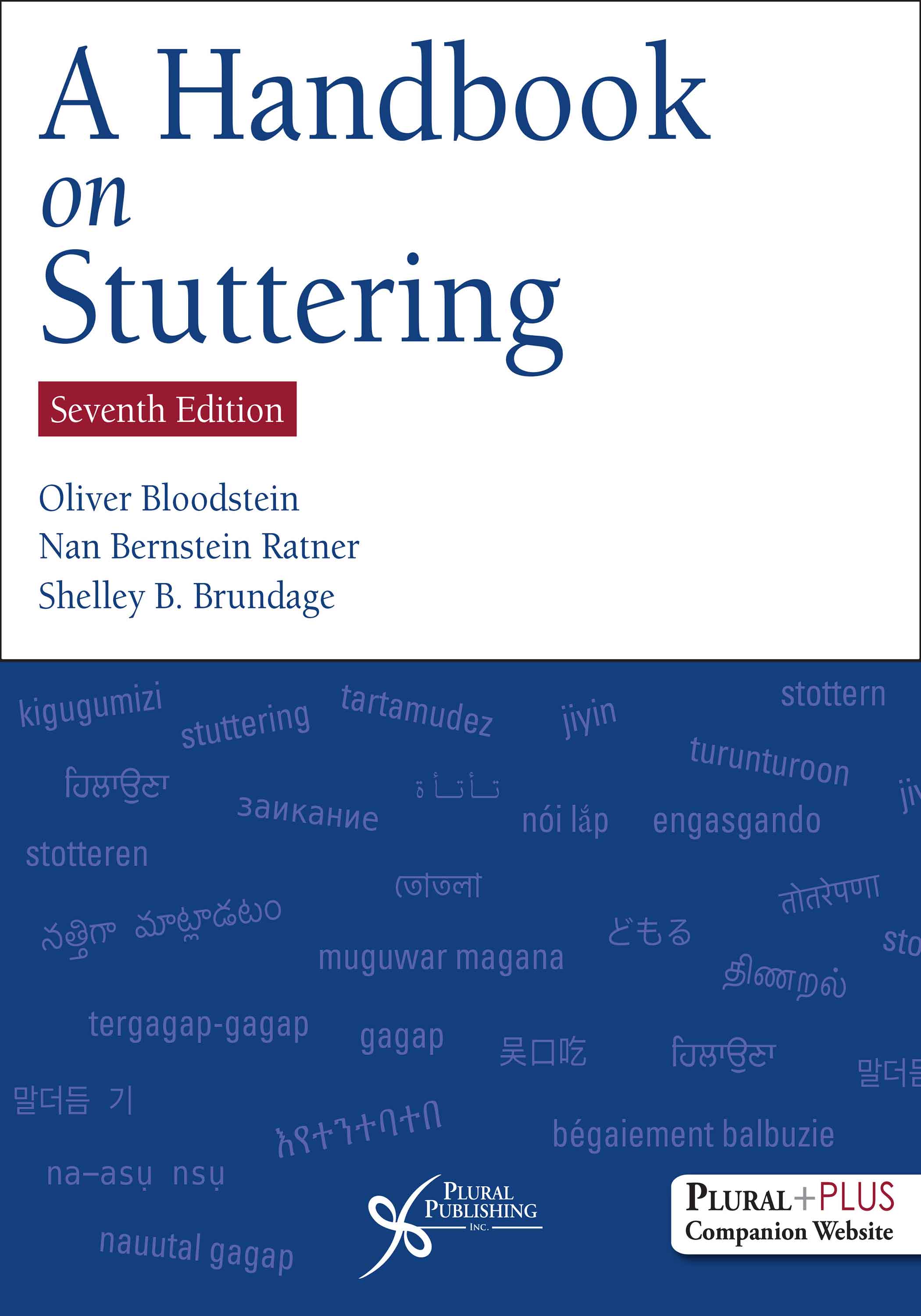
Behavior Assessment Battery for School-Age Children Who Stutter (BAB)
First Edition
Gene J. Brutten, Martine Vanryckeghem
Details: Boxed Set, B&W, 8.5" x 11" - Includes Test Manual, Speech Situation Checklists, Behavior Checklist, Communication Attitude Test, Test Forms, Norm Sheet, and Scoring Key
ISBN13: 978-1-59756-114-3
© 2007 | Available
Purchase Print Book
Price: $304.95
The Behavior Assessment Battery for School-Age Children Who Stutter (BAB) is a multi-dimensional set of inter-related, evidence-based, self-report tests that provide normative data for children between the ages of six and fifteen. The Battery has evolved and been refined over many years and has been used with an innumerable number of clients all over the world.
The test procedures include:
- The Speech Situation Checklists (SSC-ER and SSC-SD) - for evaluating a child's emotional reaction to, and speech disruption in a range of speech situations
- The Behavior Checklist (BCL) - reveals the particular coping responses that a child uses to deal with dysfluency
- The Communication Attitude Test (CAT) - for measuring a child's attitude about his or her speech
These self-report test procedures provide speech pathologists and their professional colleagues—including teachers, psycho- and neurolinguists, clinical and educational psychologists, behavior therapists, and pediatricians—with a multi-dimensional view of how a child is affected by how they feel, react to, and think about their speech.
Through the eyes of the child whose fluency is problematic, the BAB test procedures provide a multi-dimensional picture of the speech-related aspects of the child's world that only the child can validly supply. By evaluating a child's overall score on the SSC-ER, SSC-SD, BCL and CAT and his or her reaction to the particular items that make up these test procedures, clinicians can determine the treatment strategies and tactics, that are most likely to be successful. This battery serves to give shape to therapy by providing the therapist with clear-cut indications of a child's speech-associated strengths and weaknesses and their particular needs.
Beautifully presented in a convenient and handy boxed set, the BAB comprises:
- Test Manual
- Speech Situation Checklists
- Behavior Checklist
- Communication Attitude Test
- Test Forms
- Norm Sheet
- Scoring Key
FROM THE AUTHORS
The self-report measures of the Behavior Assessment Battery are, in part, an outgrowth of the fact that there is no universally agreed upon definition of stuttering. The count of speech disruption displayed by a child is known to vary markedly, even among fluency specialists, is often unreliable, and thus of questionable validity relative to diagnostic determination and the measurement of clinical improvement.
The identification of a child as one who stutters involves more than the presence of dysfluency even when limited to the within-word repetitions and prolongations that listeners tend to regard as atypical and different from normal. Though dysfluencies are obviously necessary for a child to be identified as one who stutters, it is fully evident that they are not sufficient to do so. Moreover, children who stutter are more than youngsters who are dysfluent. They react to their dysfluencies and/or view their speech ability in ways that tend to be different from that of their normally fluent peers. Clinicians have long recognized this and have used this reactivity to augment their evaluation of children whose fluency is problematic. This has generally been done in an informal manner or has involved one or another measure of speech-associated reactivity that has not been standardized and does not provide norms that permit a comparison between children who do or do not stutter.
The current forms of the BAB test procedures have been updated and its wording has been made more understandable and meaningful to school-age children. They highlight the affective, behavioral, and cognitive reactions that a child has about his or her speech ability. This information aids the clinician in differential diagnostic determinations and in shaping the strategy and tactics of therapy that are relevant to the reactive needs of a child who stutters (CWS). They do so by providing the clinician with an 'inside view' of how a child feels, reacts to, and thinks about their speech in a way that compliments the clinician's observation of a youngster's behavior.
Recently, we have added to the BAB, the KiddyCAT, a companion test procedure that measures the communication attitude of preschool and kindergarten children. The research data that have resulted from investigations with the KiddyCAT indicate that, as a group, preschool children who stutter have a speech-related attitude that is significantly more negative than that of their nonstuttering peers. This finding has considerable clinical significance. A child's KiddyCAT score can serve as a meaningful aid in the early detection and treatment of a child whose fluency is problematic.
To replenish your supply of forms, click on the following links:
- Behavioral Checklist (BCL) Reorder Set
- Speech Situation Checklist-Emotional Response (SSC-ER) Reorder Set
- Speech Situation Checklist-Speech Disruption (SSC-SD) Reorder Set
- Communication Attitude Test (CAT) Reorder Set
Reviews
"The CAT and the SSC are the most effectively standardized self-report approaches to beliefs, feelings, and behavior of stuttering children being employed at present for research and clinical purposes."
—Hugo Gregory, Stuttering Therapy: Rationale and Procedures (2003)
"I use the Speech Situation Checklist and the Behavior Checklist in my work with those who stutter because of their beautiful simplicity and reliability (...) and recommend them to clinicians’ concerned with the care of those who stutter."
—Peggy Janssen, Speech Pathologist and Researcher, University Medical Center, Utrecht, The Netherlands. Author of Behavior Therapy for Stuttering
"This is a must have manual for any clinician seeing children who stutter. It is the first assessment tool that combines information on speech-associated negative emotion, voluntary behaviors designed to avoid, escape or hide stuttering and mal-attitude towards speech. It helps clinicians distinguish PWS from PWNS by means other than dysfluency counts. FOUR STARS"
—Jeanne McHugh, M.S., George Washington University, Doody Enterprises, Inc., Doody's Book Reviews
"The BAB is beautifully presented in a convenient and handy boxed set... This is a very helpful instrument for therapists who work with dysfluency disorders."
—Ioannis Vogindroukas, Psychiatric Hospital of Thessaloniki, Folia Phoniatrica et Logopaedica (2008)
"The Communication Attitude Test (...) provides an excellent tool for exploring not only childrens attitudes, but also feelings about their communication abilities."
—Patricia Zebrowski and Ellen M. Kelly, Manual of Stuttering Intervention (2006)
"The CAT significantly identifies those children with negative speech-associated attitudes... (and) provides insight into the intrapersonal and interpersonal beliefs surrounding communication."
—Ellen M. Bennett, Working with People Who Stutter (2006)
Support in Published Journal Articles
From Jones, M., Menzies, R., Onslow, M., Lowe, R., O’Brian, S., & Packman, A. (2021). Measures of Psychological Impacts of Stuttering in Young School-Age Children: A Systematic Review. Journal of Speech, Language, and Hearing Research, 64, 1918–1928.
p. 1918: “Based on the criterion defined by the Terwee et al. (2007) appraisal tool, the Communication Attitude Test and the Overall Assessment of the Speaker’s Experience of Stuttering for School-Age Children received the highest number of ratings in support of their measurement properties”.
Internal consistency:
p. 1924: “Cronbach’s alpha scores … of adequate magnitude were found for … the CAT, the SSC-ER, the BCL, …”
p. 1924: “Construct validity concerns the correlation of test scores on measures of related and unrelated constructs. The CAT was the only measure to receive a positive rating. The …SSC- ER, and the BCL … received intermediate ratings”.
p. 1925: “Responsiveness refers to the sensitivity of a measure to identify changes over the course of time (Terwee et al., 2007). Information on responsiveness could only be found for the CAT.”
p. 1925: “A floor or ceiling effect refers to participant scoring that is skewed toward the maximum or minimum scores on an instrument (Franic & Bothe 2008; Terwee et al., 2007)… Information regarding this criterion was found for … the CAT, and the SSC-ER. The latter two measures received a positive rating.”
p. 1925: “Interpretability of test scores was available for … all components of the BAB”.
From page 1,076 in Longland, A. (2009). Behavior Assessment Battery for School-Age Children Who Stutter. Book Review. International Journal of Language and Communication Disorders, 44/6, 1075–1076:
“…the BAB provides a tool that brings together information related to children’s feelings, reactions, and thoughts about their speech. Currently, there is no other assessment available that collects the same amount and type of information or that provides valid normative data on this population of children.”
“Whilst most clinicians currently rely on measurements of speech disfluencies alone to diagnose children who stutter, the information obtained from the BAB adds depth and enables a more comprehensive assessment and, therefore, a more reliable diagnosis.The results and interpretation of the BAB could form a useful base for discussion with anxious parents and/or school staff.”
“…it certainly provides a very useful tool for diagnosis and for the planning and evaluation of intervention.”

Behavior Assessment Battery CAT-Communication Attitude Test Reorder Set
First Edition
Gene J. Brutten, Martine Vanryckeghem
Details: 4 pages, B&W, Saddle Stitched, 8.5" x 11"
ISBN13: 978-1-59756-123-5
© 2007 | Available

Behavior Assessment Battery SSC-ER-Speech Situation Checklist Reorder Set
First Edition
Gene J. Brutten, Martine Vanryckeghem
Details: 8 pages, B&W, Saddle Stitched, 8.5" x 11"
ISBN13: 978-1-59756-125-9
© 2007 | Available

Behavior Assessment Battery BCL-Behavior Checklist Reorder Set
First Edition
Gene J. Brutten, Martine Vanryckeghem
Details: 4 pages,B&W, Saddle Stitched, 8.5" x 11"
ISBN13: 978-1-59756-126-6
© 2007 | Available

Behavior Assessment Battery SSC-SD-Speech Situation Checklist Reorder Set
First Edition
Gene J. Brutten, Martine Vanryckeghem
Details: 8 pages, B&W, Saddle Stitched, 8.5" x 11"
ISBN13: 978-1-59756-127-3
© 2007 | Available

KiddyCAT Communication Attitude Test for Preschool and Kindergarten Children Who Stutter
First Edition
Martine Vanryckeghem, Gene J. Brutten
Details: 28 pages, B&W, Softcover, 8.5" x 11"
ISBN13: 978-1-59756-117-4
© 2007 | Available

KiddyCAT Reorder Set Communication Attitude Test for Preschool and Kindergarten Children Who Stutter
First Edition
Martine Vanryckeghem, Gene J. Brutten
Details: 50 pages, B&W, Pad, 8.5" x 11"
ISBN13: 978-1-59756-124-2
© 2007 | Available

Behavior Assessment Battery for Adults Who Stutter (Online Access)
First Edition
Martine Vanryckeghem, Gene J. Brutten
Details: Online Access
ISBN13: 978-1-59756-901-9
© 2018 | Available

A Handbook on Stuttering
Seventh Edition
Oliver Bloodstein, Nan Bernstein Ratner, Shelley B. Brundage
Details: 581 pages, B&W, Hardcover, 8.5" x 11"
ISBN13: 978-1-63550-317-3
© 2021 | Available

